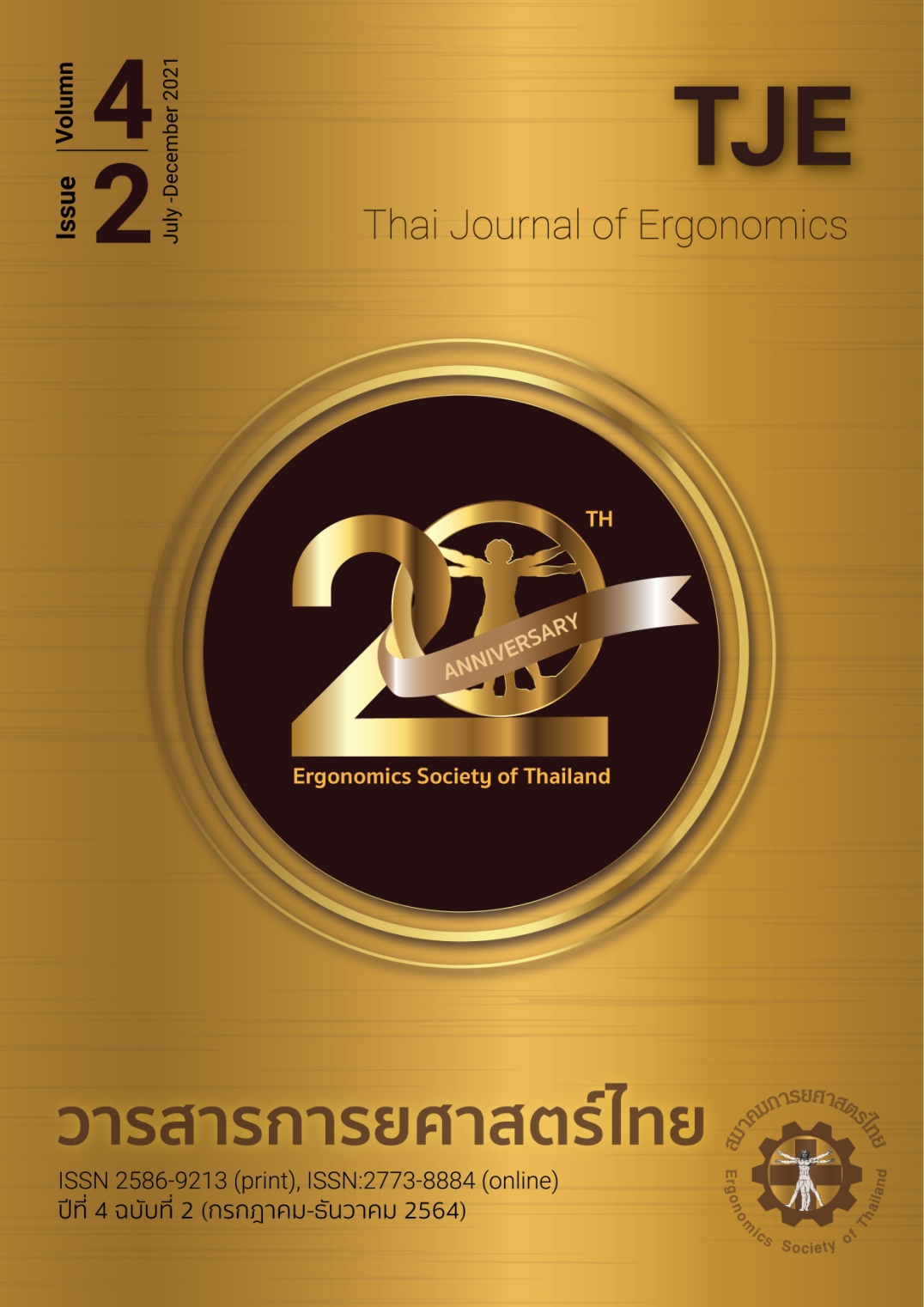Review of cognitive ergonomics assessment methods
Main Article Content
Abstract
Cognitive Ergonomics is one of the Ergonomics domains, and this is a new topic of academic society in Thailand. According to literature review, this topic has been gradually interested in research society around the world. However, this research domain is not widely investigated in Thailand. Limit of cognitive ergonomics research has been published in Thailand. Thus, this article summarized the definition of Cognitive Ergonomics and provided research examples and methods to investigate Cognitive Ergonomics. Particularly, two main topics were discussed in this article including Mental Workload and Situation Awareness. Each topic described the several techniques and methods to assess these issues. It is expected that this article is useful for the researchers in cognitive ergonomics research area.
Article Details
References
Matt Middlesworth. Ergonomics 101: The definition, domains, and applications of ergonomics. 2021 [cited 2021 Jan 20]. Available from: https://ergo-plus.com/ergonomics-definition-domains-applications/
สถาบันส่งเสริมความปลอดภัย อาชีวอนามัย และสภาพแวดล้อมในการทำงาน (องค์การมหาชน). คู่มือการปรับปรุงการปฏิบัติงานยกและเคลื่อนย้ายวัสดุด้วยแรงกายตามหลักการยศาสตร์. พิมพ์ครั้งที่ 1. กรุงเทพฯ: บริษัท ชยากร พริ้นติ้ง จำกัด; 2562.
Reinerman-Jones L, Matthews G, Mercado JE. Detection tasks in nuclear power plant operation: vigilance decrement and physiological workload monitoring. Saf Sci. 2016;88:97-107.
Fernandes A, Braarud, PØ. Exploring measures of workload, situation awareness, and task performance in the main control room. Procedia Manuf. 2015;3:1281-8.
Stapel J, Mullakkal-Babu FA, Happee R. Automated driving reduces perceived workload, but monitoring causes higher cognitive load than manual driving. Transp Res F: Traffic Psychol Behav. 2019;60:590-605.
Young MS, Brookhuis KA, Wickens CD. Hancock PA. State of science: mental workload in ergonomics. Ergonomics 2015;58:1-17.
Paxion J, Galy E, Berthelon C. Mental workload and driving. Front Psychol. 2014;5:1344.
De Winter JC, Happee R, Martens MH, Stanton NA. Effects of adaptive cruise control and highly automated driving on workload and situation awareness: a review of the empirical evidence. Transp Res F: Traffic Psychol Behav. 2014;27:196-217.
Butmee T, Lansdown TC, Walker GH. Mental workload and performance measurements in driving task: a review literature. In: Bagnara S, Tartaglia R, Albolino S, Alexander T, Fujita Y. Editors. IEA 2018. Proceedings of the 20th Congress of the International Ergonomics Association; 2018 Aug 26-30; Florence: Italy. Cham: Springer Nature; 2018. p. 286-94.
Hart SG, Staveland LE. Development of NASA-TLX (Task Load Index): results of empirical and theoretical research. In: Hancock P, Meshkati N, editors, Human mental workload. North Holland: Amsterdam; 1988. p. 139-183.
Reid GB, Nygren TE. The subjective workload assessment technique: A scaling procedure for measuring mental workload. In: Hancock P, Meshkati N, editors, Human mental workload. North Holland: Amsterdam; 1988. p. 185-218.
Zijlstra FRH. Efficiency in work behaviour: A design approach for modern tools [Internet]. 1993 [cited 2021 Jan 20]. Available from: https://www.elibrary.ru/item.asp?id=6863266
Wierwille W, J Casali. A validated rating scale for global mental workload measurement applications. In: Pope AT, Haugh LD, editors. Proceedings of the Human Factors Society 27th Annual Meeting; 1983 Oct 10-14 Norfolk: USA. Santa Monica: Human Factors Society; 1983 p. 129–33.
Donmez B, Cummings ML, Graham HD, Brzezinski AS. Modified cooper harper scales for assessing unmanned vehicle displays. In: Messina E, Madhavan R, editors. Proceedings of the 10th Performance Metrics for Intelligent Systems Workshop; 2010 Sep 28-30 Baltimore: USA. New York: Association for Computing Machinery; 2010 p. 235-42.
Cantin V, Lavallière M, Simoneaub M, Teasdale N. Mental workload when driving in a simulator: Effects of age and driving complexity. Accid Anal Prev. 2009;41:763–71.
Longo L. A defeasible reasoning framework for human mental workload representation and assessment. Behav Inf Technol. 2015;34:758-86.
de Waard D. The measurement of drivers' mental workload. Netherlands: Groningen University, Traffic Research Center; 1996.
O’Donnell RD, Eggemeier FT. Workload assessment methodology. In: Boff KR, Kaufman L, Thomas JP editors. Handbook of perceptionand human performance. Volume 2. Cognitive processes and performance. New York: Wiley-Interscience; 1986. p. 42-9.
Endsley MR. Design and evaluation for situation awareness enhancement. Proc Hum Factors Ergon Soc Annu Meet. 1988;97-101.
Salmon PM, Stanton NA, Walker GH, Jenkins D, Ladva D, Rafferty L et al. Measuring situation awareness in complex systems: comparison of measures study. Int J Ind Ergon. 2009;39:490-500.
Endsley MR. Measurement of situation awareness in dynamic systems. Hum Factors. 1995;37: 65–84.
Durso FT, Hackworth CA, Truitt T, Crutchfield J, Manning C.A. Situation awareness as a predictor of performance in en route air traffic controllers. Air Traffic Control Q. 1998; 6:1–20.
Taylor RM. Situational Awareness Rating Technique (SART): the development of a tool for aircrew systems design. In: Situation awareness in Aerospace operations (AGARD-CP-478). Neuilly Sur Seine: NATO-AGARD; 1990 p. 3/1 –3/17.
Matthews MD, Beal SA. Assessing situation awareness in field training exercises. U.S. Army Research Institute for the Behavioural and Social Sciences; 2002.
Smolensky MW. Toward the physiological measurement of situation awareness: the case for eye movement measurements. In: Proceedings of the Human Factors and Ergonomics Society 37th Annual Meeting. 1993 Oct 11-15 Seattle: USA. Santa Monica: Human Factors and Ergonomics Society; 1993 p. 41.


